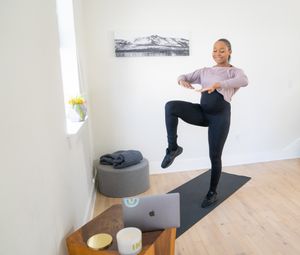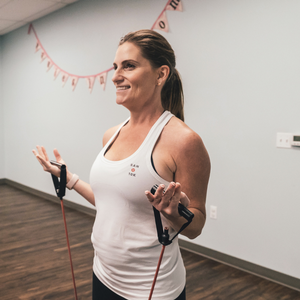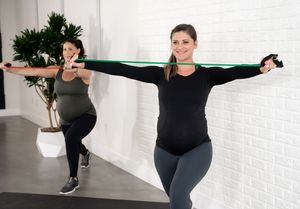
Training By Trimester: 3rd Trimester
FIT4MOM x Jessica Maurer
By the 3rd Trimester, final adaptations are taking place to prepare your body for delivery, and your exercise possibilities will be further affected. The 3rd Trimester is often a time to alter the fitness program due to weight gain, the growing belly, increased spinal misalignment issues, and the burden of the extra load you are carrying.
Although total blood volume continues to expand, the increased heart rate will plateau by the 3rd Trimester, and stroke volume and cardiac output should begin to decrease. The enlarging uterus continues to push on the diaphragm, so the air volume in the lungs after each exhalation falls considerably. This causes a decrease in oxygen reserve and uptake and may make catching your breath seem more difficult. Higher-intensity exercise can become more challenging, and losing your breath with less intense movements is easier.
Remember, your pelvic floor is similar to a hammock. At this point, the weight of the uterus is causing the hammock to stretch downward, weakening this group of muscles and causing strain. Remember, the pelvic floor is not the only muscle that connects to the pelvis, and muscles such as the glutes and lower back will also feel the strain. This stress can make impact uncomfortable for women, and some women will opt out of all impact options during this trimester. However, remember each pregnancy is different, and we empower moms through choice.
Many moms-to-be lose the desire to continue exercising through the 3rd Trimester. But we encourage you to stay consistent. While you may be tired and low on energy, exercise can increase your energy levels. Remember the correlation between fitness and ease of labor and delivery (in normal, uncomplicated deliveries).
Just as we advocated throughout the 1st Trimester and the 2nd Trimester, we want to encourage you to continue moving throughout the 3rd Trimester. Let's dive into our Start, Stop, and Continue for fitness in the 3rd Trimester.
START
Start focusing more on releasing movements with your breathing. Contractions are important for muscular strength and growth, whether concentric or eccentric; in the 3rd Trimester, releasing out of all contractions becomes very important.
In between each repetition, find a strong posture and use your inhalation to release the tension from all muscles in your body fully. This is especially true for your pelvic girdle, floor, core, glutes, lower back, and shoulders, where most 3rd Trimester moms complain of tension or stress.
In addition to your exercise contractions, you will experience uterine contractions throughout the last three months of pregnancy. Contractions feel like a tightening of the abdomen, sometimes reported as a pinching feeling. These early contractions, called Braxton Hicks contractions, are the body's way of preparing for birth and are normal. These contractions do not happen at regular intervals, do not dilate the cervix, and will intensify as the fetus is closer to birth.
The focus on releasing is vital to your pelvic floor health. Many women think "releasing" means pressing down on the pelvic floor; this can damage those stressed muscles. Releasing should be gentle, slow, and tied to the inhale. The same method for releasing your muscles will come into play when you are asked to release during labor.
You might start feeling mild, sporadic contractions, especially when tired or dehydrated. You may notice these occurring more after or during a workout session. Drink water, change positions, and, most importantly, focus on releasing your breath, body, and mind.
STOP
It’s time to stop being prone during exercise. This includes lying, quadruped, and plank poses in most situations. As the pregnancy progresses, the baby's size and position can put pressure on the abdomen and make lying face down (prone position) uncomfortable or even painful for some women. There's an increased risk of straining the front muscles of the core while prone due to the additional weight in the belly and breasts - this can cause undue stress and harm to the linea alba, which is already stretched.
However, we know that prone positions are important to proper level changes and activities of daily living. This position cannot be entirely avoided in the 3rd Trimester, but we should encourage our clients to limit the time spent here and not to train in prone for fitness purposes.
Consider these modifications to a 3rd Trimester fitness routine:
Elevated Surface: One approach uses an elevated surface, like an incline bench, chair, or wall. This reduces the pressure on the abdomen and allows the individual to perform the exercise at a more comfortable angle.
Alternative Exercises: Instead of traditional prone exercises, you can incorporate exercises that focus on strengthening the back and core without putting undue pressure on the abdomen. For instance, exercises using resistance bands or cable machines can be effective alternatives.
Other Core Training Position: Exercises in seated, side-lying, or standing positions are still beneficial. These exercises focus on engaging the core muscles without stressing the linea alba.
CONTINUE
Move in whatever way feels the most comfortable and brings you the most joy. You can continue with impact as well. It's just at this stage, you may choose not to. Your exercise choice is based on your comfort levels. At this stage, you may not be comfortable with high-impact motions. You may not even be comfortable with moderate impact options.
Speaking of intensity, you may want to lessen your intensity at this stage in pregnancy. You are becoming more fatigued, you’re carrying more weight, and your body is preparing for birth, which will cause you to slow down a little bit. We will also encourage you to slow down your fitness routine regarding transitions and gait. Can you continue at the same intensity level as before? Yes. However, you may choose not to, and that, of course, is your choice.
Do you want more information and guidance? Motherhood is a transformative journey filled with joy, challenges, and the need for incredible strength. Since 2001, FIT4MOM has been the leader of prenatal and postnatal fitness, supporting moms nationwide through our network of franchise owners and dedicated instructors. To further support our mission of helping all moms find their Strength in Motherhood®, we are thrilled to announce our first-ever certification course available to all fitness professionals: FIT4MOM’s Prenatal & Postnatal Fitness Certification.
Let's empower moms to find their Strength in Motherhood® and unlock their full potential for everyday life as a new parent. Motherhood is an extraordinary experience; with FIT4MOM, you can make it even more empowering for your clients.
WANT TO LEARN MORE?
Bringing new life into the world is a miraculous and life-altering experience, but it's no secret that pregnancy and postpartum can bring a whirlwind of changes to a woman's body. As a fitness professional or health enthusiast, you have the power to support and empower mothers on their journey to a healthy pregnancy, a smoother birth experience, and a robust postpartum recovery.
Register here to receive more information for training the female client.
WANT MORE, MAMA?
Other blogs about pregnancy you'll enjoy:





